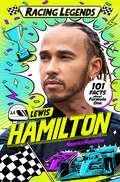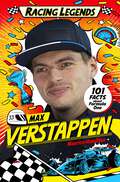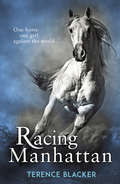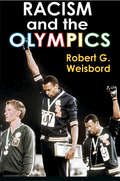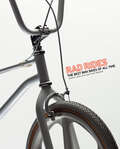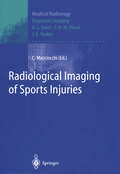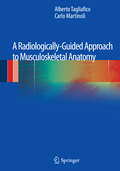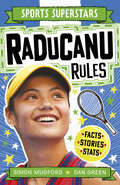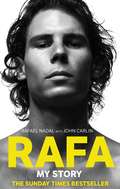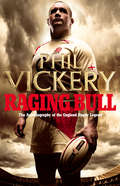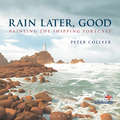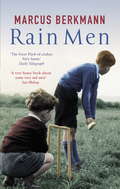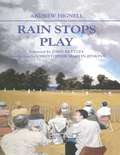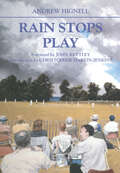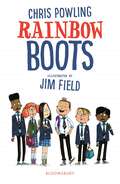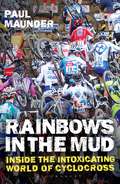- Table View
- List View
Racing Hard
by William FotheringhamFew British schoolchildren of the seventies can have been as obsessed with the Tour de France as William Fotheringham, who smuggled copies of Miroir du Cyclisme into lessons to read inside his books. He saw the Tour for the first time in 1984, avidly following that year's race on television in the Normandy village where he lived. Since joining the Guardian in 1989, William Fotheringham has been at the forefront of British cycling journalism. Here he reflects on the events of the last twenty-three years - the triumphs, the tragedies and the scandals that have engulfed the world's most demanding sport. Key articles from his career are annotated with notes and reflections. What would he have said if he'd known then what we all know now about Lance Armstrong? Which cyclists and teams were not all they seemed? And which victories still rank as the greatest of all time?This is the definitive collection of cycling reporting.
Racing Horse and Jockey (large print)
by RnibThis page shows an image of a galloping horse and its rider. There is a locator dot shown, which will be at the top left when the image is the correct way up. The horse is shown from the side with its head on the left and its tail on the right. On the left of its head is a large flaring nostril allowing the horse to suck in lots of air. Down from this is its closed mouth. To the right is the bit which is in the horse's mouth as well. There is a ring attached to the bit. Bridle straps go from the ring around various parts of the horse's head. Up from the ring is one of the horse's two eyes. Up and right from here a backward pointing ear sticks up. Right from the ear is the hairy mane sticking up from the horse's neck. The rein goes from the ring to the right and disappears into the mane. It is being held by the jockey on the other side of the horse's neck. Right from the neck is the horse's body. Down from the body are four legs, some are bent sharply as the horse gallops. On the right of the page the horse's tail flies out to the right. Up from the body of the horse is the jockey in a crouched position. He is seen from the side so only one leg, one arm and hand, and part of one arm is shown. He is bending forward so that his face is just up from the horse's mane. He wears a large pair of goggles so his eye cannot be found. He has a green jockey's cap on his head. Down and right from his cap you will find his bent arm with his hand holding a riding crop (whip). His leg is sharply bent and he wears a riding boot on his lower leg. The boot is held in the stirrup and this takes his full weight as he is not actually sitting on the horse. Down from the jockey's bottom is the saddle on the horse's back. This is held in place with a broad strap that goes around the horse's belly.
Racing Horse and Jockey (UEB contracted)
by RnibThis page shows an image of a galloping horse and its rider. There is a locator dot shown, which will be at the top left when the image is the correct way up. The horse is shown from the side with its head on the left and its tail on the right. On the left of its head is a large flaring nostril allowing the horse to suck in lots of air. Down from this is its closed mouth. To the right is the bit which is in the horse's mouth as well. There is a ring attached to the bit. Bridle straps go from the ring around various parts of the horse's head. Up from the ring is one of the horse's two eyes. Up and right from here a backward pointing ear sticks up. Right from the ear is the hairy mane sticking up from the horse's neck. The rein goes from the ring to the right and disappears into the mane. It is being held by the jockey on the other side of the horse's neck. Right from the neck is the horse's body. Down from the body are four legs, some are bent sharply as the horse gallops. On the right of the page the horse's tail flies out to the right. Up from the body of the horse is the jockey in a crouched position. He is seen from the side so only one leg, one arm and hand, and part of one arm is shown. He is bending forward so that his face is just up from the horse's mane. He wears a large pair of goggles so his eye cannot be found. He has a green jockey's cap on his head. Down and right from his cap you will find his bent arm with his hand holding a riding crop (whip). His leg is sharply bent and he wears a riding boot on his lower leg. The boot is held in the stirrup and this takes his full weight as he is not actually sitting on the horse. Down from the jockey's bottom is the saddle on the horse's back. This is held in place with a broad strap that goes around the horse's belly.
Racing Horse and Jockey (UEB uncontracted)
by RnibThis page shows an image of a galloping horse and its rider. There is a locator dot shown, which will be at the top left when the image is the correct way up. The horse is shown from the side with its head on the left and its tail on the right. On the left of its head is a large flaring nostril allowing the horse to suck in lots of air. Down from this is its closed mouth. To the right is the bit which is in the horse's mouth as well. There is a ring attached to the bit. Bridle straps go from the ring around various parts of the horse's head. Up from the ring is one of the horse's two eyes. Up and right from here a backward pointing ear sticks up. Right from the ear is the hairy mane sticking up from the horse's neck. The rein goes from the ring to the right and disappears into the mane. It is being held by the jockey on the other side of the horse's neck. Right from the neck is the horse's body. Down from the body are four legs, some are bent sharply as the horse gallops. On the right of the page the horse's tail flies out to the right. Up from the body of the horse is the jockey in a crouched position. He is seen from the side so only one leg, one arm and hand, and part of one arm is shown. He is bending forward so that his face is just up from the horse's mane. He wears a large pair of goggles so his eye cannot be found. He has a green jockey's cap on his head. Down and right from his cap you will find his bent arm with his hand holding a riding crop (whip). His leg is sharply bent and he wears a riding boot on his lower leg. The boot is held in the stirrup and this takes his full weight as he is not actually sitting on the horse. Down from the jockey's bottom is the saddle on the horse's back. This is held in place with a broad strap that goes around the horse's belly.
Racing Legends: Lewis Hamilton (Racing Legends #1)
by Maurice HamiltonRace through fun facts, stats and stories about one of your favourite drivers Lewis Hamilton, with F1 expert, Maurice Hamilton.Find out how Lewis Hamilton went from playing with remote-controlled cars to becoming one of the world's greatest ever RACING LEGENDS! Covering speed records and epic rivalries, as well as Hamilton's heroes and charity work, this book shows just how legendary Lewis Hamilton is, on and off the track, and celebrates the unsung heroes of racing, from the pitstop crew to the engineers.Easy to read, fun to share and packed with illustrations, Racing Legends: Lewis Hamilton is perfect for fast and curious minds, whatever their reading ability. Check out the rest of the Racing Legends series for more books to speed through!
Racing Legends: Max Verstappen (Racing Legends #2)
by Maurice HamiltonRace through fun facts, stats and stories about one of your favourite drivers Max Verstappen, with F1 expert, Maurice Hamilton.Find out how Max Verstappen went from go-karting to becoming one of the world's best RACING LEGENDS! Detailing his super-fast rise to fame this book shows just how much of a legend Max Verstappen is, as well as shedding light on the team that helped him become number 1 in F1.Easy to read, fun to share and packed full of illustrations, Racing Legends: Max Verstappen is perfect for fast and curious minds, whatever their reading ability. Check out the rest of the Racing Legends series for more books to speed through!
Racing Manhattan
by Terence BlackerJay Barton has spent her life on the outside, being overlooked and mocked for her tomboy ways. All she wants to do is ride her favourite pony, which belongs to her much wealthier cousin. But then Jay shows a talent for winning the illegal pony races her uncle takes her to, and he starts to push her to take more and more risks. At 15, Jay decides to run away, to live the life of a stable hand.Her fortunes are changed when she meets Manhattan: a pedigree grey racehorse who has used up all her chances and is now neglected and despised. Jay recognises a fellow misfit. She fights to give Manhattan one last opportunity to show she is the champion she was born to be. Together, they face a world of prejudice and cruelty and fight back the only way they know – by becoming the best.
Racing Through the Dark: The Fall and Rise of David Millar
by David MillarThe SUNDAY TIMES bestselling memoir from the Tour de France cyclist who lifts the lid on his drug use and return to sport.By his eighteenth birthday David Millar was living and racing in France, sleeping in rented rooms, tipped to be the next English-speaking Tour winner. A year later he'd realised the dream and signed a professional contract. He perhaps lived the high life a little too enthusiastically - he broke his heel in a fall from a roof after too much drink, and before long the pressure to succeed had tipped over into doping. Here, in a full and frank autobiography, David Millar recounts the story from the inside: he doped because 'cycling's drug culture was like white noise', and because of peer pressure. 'I doped for money and glory in order to guarantee the continuation of my status.' Five years on from his arrest, Millar is clean and reflective, and holds nothing back in this account of his dark years.
Racism and Anti-Racism in Football
by Jon Garland Michael RoweThis book explores the key issues of racism, anti-racism and identity in British football. It relates the history of black players in the game, analyses the racism they have experienced, and evaluates the efficacy of anti-racist campaigns. The efficacy of the policing of racism is also assessed. The nationalism and xenophobia evident in much of the media's coverage of major tournaments is highlighted in the context of the way that English, Scottish and Welsh identities are constructed within British football.
Racism and the Olympics
by Robert G. WeisbordSports are the opiate of the people, particularly in the United States, Europe, and parts of South America. Globally, billions of fans feverishly focus on the summer and winter Olympics. In theory, international fraternalism is boosted by these "friendly competitions," but often national rivalries eclipse the theoretical amity. How the Olympics have dealt with racism over the years offers a window to better understanding these dynamics. Since their revival in 1896, the modern Olympics were periodically agitated by political and moral conundrums. Racial tensions, the topic of this volume, reached their apex under the polarizing presidency of Avery Brundage. Race in sports cannot be disentangled from societal problems, nor can race or sports be fully understood separately. Racial conflict must be contextualized. Racism and the Olympics explores the racial landscape against which a number of major disputes evolved. The book covers various topics and events in history that portray discrimination within Olympic games, such as the Nazi games of 1936, the black American protest on the victory stand in Mexico City's Olympics, as well as international political forces that removed South Africa and Rhodesia from the Olympics. Robert G. Weisbord considers the role of international politics and the criteria that should be used to determine nations that are selected to take part in and serve as venues for the Olympic Games.
Racism and the Olympics
by Robert G. WeisbordSports are the opiate of the people, particularly in the United States, Europe, and parts of South America. Globally, billions of fans feverishly focus on the summer and winter Olympics. In theory, international fraternalism is boosted by these "friendly competitions," but often national rivalries eclipse the theoretical amity. How the Olympics have dealt with racism over the years offers a window to better understanding these dynamics. Since their revival in 1896, the modern Olympics were periodically agitated by political and moral conundrums. Racial tensions, the topic of this volume, reached their apex under the polarizing presidency of Avery Brundage. Race in sports cannot be disentangled from societal problems, nor can race or sports be fully understood separately. Racial conflict must be contextualized. Racism and the Olympics explores the racial landscape against which a number of major disputes evolved. The book covers various topics and events in history that portray discrimination within Olympic games, such as the Nazi games of 1936, the black American protest on the victory stand in Mexico City's Olympics, as well as international political forces that removed South Africa and Rhodesia from the Olympics. Robert G. Weisbord considers the role of international politics and the criteria that should be used to determine nations that are selected to take part in and serve as venues for the Olympic Games.
The Racket: On Tour with Tennis’s Golden Generation – and the other 99%
by Conor Niland'As elegant and powerful as a Federer backhand ... It’s Kitchen Confidential for tennis.' Ed Caesar'A really wonderful read ... Conor Niland has delivered an all-timer for tennis and sports journalism' Ashlee Vance'Conor Niland may only have managed a career-high ranking of 129 – only? that is some achievement in itself! – but The Racket, his account of how he managed this, is up there with the best half-dozen books on tennis ever written.' Geoff Dyer'I ate this book up ... reveals the sacrifices, commitment and decidedly unglamorous side of life on the tennis circuit' Sinead MoriartyWhen Conor Niland was 16, he got the chance to hit with Serena Williams at Nick Bollettieri's famed tennis academy. Conor, the Irish junior number one, was feeling a bit homesick. Serena, also 16, already owned her own house beside the academy.Conor Niland knows what it's like when Roger Federer walks into the dressing room ('Ciao, bonjour, hello!'), and he has had the exquisitely terrible experience of facing Novak Djokovic in the world's biggest tennis stadium - while suffering from food poisoning. But he never reached the very top.The Racket is the story of pro tennis's 99%: the players who roam the globe in hope of climbing the rankings and squeaking into the Grand Slam tournaments. It brings us into a world where a few dozen super-rich players - travelling with coaches and physios - share a stage with lonely touring pros whose earnings barely cover their expenses. Painting a vivid picture of the social dynamics on tour, the economics of the game, and the shadows cast by gambling and doping, The Racket is a witty and revealing underdog's memoir and a unique look inside a fascinating hidden world.
Rad Rides: The Best BMX Bikes of All Time
by Gavin Lucas Stuart RobinsonBMX bikes are iconic. There’s something about them that appeals to kids, adults and cyclists. And, of course, BMX is now an Olympic sport.Rad Rides is the most in-depth exploration of the world of BMX bikes through their riders and the culture that surrounds them. The introduction explains and contextualizes the birth of BMX culture and where it is now, while the main body features bikes ranging from those that are well-worn through years of riding to beautiful, sculptural works of art – gleaming, built-but-never-ridden keepsakes. The featured bikes are organized decade by decade and are BMXs drawn from the best collections in the world. There are also in-depth details of specifications and interviews with some of the collectors, many of whom have had their bikes exclusively shot for the book. This is the indispensable companion for anyone who loves the BMX.
Radiological Imaging of Sports Injuries (Medical Radiology)
by Carlo MasciocchiSports medicine is acquiring an important role owing to the increasing number of sports-active people and professional athletes. Accurate diagnosis of the different pathological conditions is therefore of fundamental importance. This book provides an overview of the most frequently observed conditions and correlates them with sports activities, as well as documenting relatively unknown lesions of increasing significance. Diagnostic techniques are described and compared, and their roles defined; interpretative pitfalls are highlighted. All of the contributing authors have distinguished themselves in the field and have a deep knowledge of the problem involved in the diagnosis and classification of sports injuries.
A Radiologically-Guided Approach to Musculoskeletal Anatomy
by Alberto Tagliafico Carlo MartinoliFor many healthcare professionals, musculoskeletal diseases represent the "bread and butter" topic after graduation. Therefore, radiological education in respect of the musculoskeletal system is vital in ensuring adequate patient management and cost-effective use of healthcare financial resources. This book illustrates the clinical anatomy of the musculoskeletal system by means of images obtained using commercially available imaging equipment and the three main imaging techniques employed today – magnetic resonance imaging, computed tomography, and ultrasound. Based on an integrated multimodality approach, each anatomical region is presented with a special focus on clinically relevant anatomical details and the characteristic findings observed in patients referred by physicians. With almost 450 images and illustrations, A Radiologically Guided Approach to Musculoskeletal Anatomy is intended as a bridge from a standard anatomical atlas to diagnostic imaging. It will assist in the everyday interpretation of imaging studies of the musculoskeletal system, providing prompt answers to frequently encountered questions. Clinical notes and self-assessment modules are also provided. All who wish to learn more about the role of diagnostic imaging of the musculoskeletal system will find this book to be of great value. It will benefit not only medical students and residents but also radiology technologists and professionals in other fields of health care, including orthopaedists, rheumatologists, and rehabilitation specialists.
Raducanu Rules (Sports Superstars #2)
by Simon MugfordIs the newly crowned US-Open champion Emma Raducanu your ultimate sporting hero? Having turned professional only in 2018, the 18-year-old British tennis star has taken the game by storm! The signs were already there when Emma made her main draw Grand Slam debut at the 2021 Wimbledon Championships, where she reached the quarter final. But it was her amazing triumph at the 2021 US Open that has shocked the world and made her into a household name. Now you can read her story. Packed with cool facts, delightfully fun illustrations and inspirational quotes, Sports Superstars: Raducanu Rules promises to be a page turner for young fans, who want to be inspired by the new golden girl of tennis.The Sports Superstars series is aimed at building a love of reading from a young age, with fun cartoons, inspirational stories, a simple narrative style and a cast of characters chipping in with quotes, jokes and comments.
Rafa: My Story
by John Carlin Rafael NadalThe Sunday Times bestselling autobiography from the greatest tennis player of his generation'A winner' Independent 'A terrific sporting memoir, full of memorable anecdotes' New Statesman 'As exciting as Rafa himself' Woman's OwnNo tennis player since Andre Agassi has captivated the world like Rafael Nadal. He's a rarity in today's sporting arena - a true sportsman who chooses to let his raw talent, dedication and humility define him. With a remarkable 16 grand slam victories under his belt, and with friend and rival Roger Federer's record haul of 20 in his sights, Nadal is an extraordinary competitor whose ferocity on court is made even more remarkable by his grace off it.This book takes us to the heart of Nadal's childhood, his growth as a player, and his incredible career. It includes memorable highs and lows, from victory in the 2008 Wimbledon final - a match that John McEnroe called the 'greatest game of tennis ever played' - to the injury problems that have frequently threatened his dominance of the sport, to becoming the youngest player of the open era to complete a career Grand Slam in 2010. It transports us from Nadal's lifelong home on the island of Majorca to the locker room of Centre Court as he describes in detail the pressures of competing in the greatest tournament in the world. It offers a glimpse behind the racquet to learn what really makes this intensely private person - who has never before talked about his home life - tick. And it provides us with a story that is personal, revealing and every bit as exciting as Nadal himself.
Raging Bull: My Autobiography
by Phil VickeryFrom a pint and a pie to ice baths and deep tissue massages … from Cornish Colts to World Cup final captain … from qualified cattle inseminator to owner of a sports fashion label … Phil Vickery, aka "Raging Bull", has pretty such seen and done it all in life and in rugby, straddling the amateur and professional eras like a bovine colossus.
Rain Later, Good: Painting the Shipping Forecast
by Peter CollyerRain Later, Good is the award winning story of Peter Collyer's extraordinary journey around the Shipping Forecast areas and has been a bestseller since first publication. The artist's brilliant and detailed paintings reproduced actual size, offer a series of images which help conjure up the most mythical locations, whilst his delightful idiosyncratic text provides a wealth of fascinating insights. He introduces us to the people who live and work in these areas, and passes on snippets of tantalising information to give a powerful impression of the place and convey a real feeling of being there. The beautiful paintings which come from Peter Collyer's travels truly capture the spirit of these wild and isolated spots.This is a book to be treasured, and its reissue will be welcomed by Peter's many admirers. 'A very remarkable painter. His work is simply stunning with an observed intensity which makes him very special indeed.' Chris Beetles in The Daily Telegraph 'The most delightful and unexpected book I've encountered this year... a wonderful book.' John Naughton, The Times
Rain Men: The Madness Of Cricket
by Marcus BerkmannThere are many cricket books, and they are all the same. 'Don't Tell Goochie', autobiographical insights of nights on the tiles in Delhi with Lambie and the boys; 'Fruit cake days', a celebrated humourist recalls 'ball' - related banter of yore; and Wisden, a deadly weapon when combined with a thermos flask. Rain Men is different. Like the moment the genius of Richie Benaud first revealed itself to you, it is a cricketing epiphany, a landmark in the literature of the game.Shining the light meter of reason into cricket's incomparable madness, Marcus Berkmann illuminates all the obsessions and disappointments that the dedicated fan and pathologically hopeful clubman suffers year after year - the ritual humiliation of England's middle order, the partially-sighted umpires, the battling average that reads more like a shoe size. As satisfying as a perfectly timed cover drive, and rather easier to come by, Rain Men offers essential justification for anyone who has ever run a team-mate out on purpose or secretly blubbed at a video of Botham's Ashes.
Rain Stops Play: Cricketing Climates (Sport in the Global Society)
by Andrew HignellA geographical history of cricket in England and Wales in a global context.
Rain Stops Play: Cricketing Climates (Sport in the Global Society #No. 27)
by Andrew HignellA geographical history of cricket in England and Wales in a global context.
Rainbow Boots (High/Low)
by Jim Field Chris PowlingAll the kids in school have a pair of Rainbow Boots – well, all of them except Denzil! So he pretends that his are being customised and soon he's trapped in a web of lies. But are the Rainbow Boots really worth all this hassle? A hilarious school comedy from popular writer Chris Powling with illustrations from the brilliant Jim Field.Bloomsbury High Low books encourage and support reading practice by providing gripping, age-appropriate stories for struggling and reluctant readers, those with dyslexia, or those with English as an additional language. Printed on tinted paper with a dyslexia friendly font, Rainbow Boots is aimed at readers aged 9+ and has a manageable length (64 pages) and reading age (7+).Produced in association with reading experts at Catch Up, a charity which aims to address underachievement caused by literacy and numeracy difficulties.
Rainbow Boots (High/Low)
by Chris Powling Jim FieldAll the kids in school have a pair of Rainbow Boots – well, all of them except Denzil! So he pretends that his are being customised and soon he's trapped in a web of lies. But are the Rainbow Boots really worth all this hassle? A hilarious school comedy from popular writer Chris Powling with illustrations from the brilliant Jim Field.Bloomsbury High Low books encourage and support reading practice by providing gripping, age-appropriate stories for struggling and reluctant readers, those with dyslexia, or those with English as an additional language. Printed on tinted paper with a dyslexia friendly font, Rainbow Boots is aimed at readers aged 9+ and has a manageable length (64 pages) and reading age (7+).Produced in association with reading experts at Catch Up, a charity which aims to address underachievement caused by literacy and numeracy difficulties.
Rainbows in the Mud: Inside the Intoxicating World of Cyclocross
by Mr Paul MaunderCyclocross is no longer cycling's hidden gem. Its rapid growth in the USA and UK means this intense and dramatic sport is exploding into the mainstream. With a season running from September to February, cyclocross is cycling's only purely winter discipline, demanding a combination of athleticism, supreme technical skill and ruthless tactics for the muddy conditions. In the sport's heartland of Belgium, major races attract crowds of thousands and have a carnival atmosphere fuelled by heavy drinking, ringing cowbells and pumping airhorns. Many top riders have enthusiastic fanclubs and are national celebrities – one even had his own reality TV show. On race day, Belgian and Dutch television coverage is akin to a major football match in the UK, stretching for hours with prerace interviews, pundits and behind-the-scenes films. In Rainbows in the Mud, Paul Maunder spends a season soaking up the sport's rich culture and history, and mixing with the obsessive fans, celebrity riders, and old-fashioned patriarchs of the sport. Following the riders – novices, veterans, American, British – as they slog their way through the season, he captures the spirit of this flamboyant cult sport, and paints a picture so vibrant you can almost feel the mud under your feet and taste the beer, mulled wine and frites.


